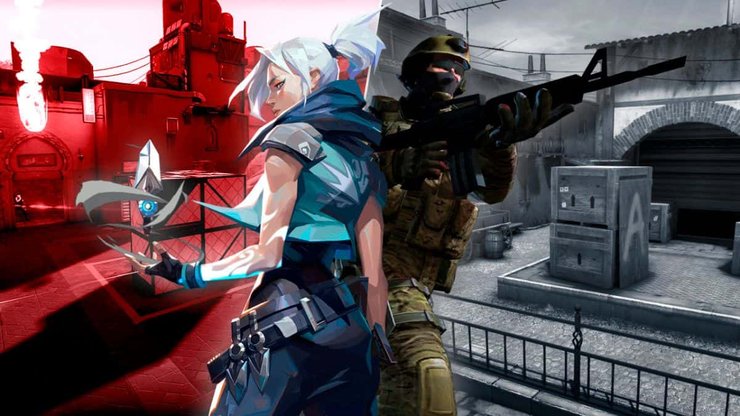Table of Contents
With millions of passionate fans and jaw-dropping prize pools, esports has firmly established itself as a significant player in the entertainment and gambling industries. Additionally, the emergence of non gamstop betting sites has introduced a new dynamic, encouraging players to engage in esports betting. These sites make wagering on these competitive events appealing because of their massive bonuses, competitive odds, wide-coverage, live streaming, and more.
Two titans competing for the ultimate dominance in the esports realm are Valorant and Counter-Strike: Global Offensive. While both are shooter games, several distinctions in their gameplay have created different fan bases, with some preferring Valorant and others opting for CS:GO. Here, we’ll explore each game and how their fan bases play a crucial role in their dominance in the industry.

Valorant X CS:GO: Understanding their Gameplay
One can’t discuss popular games in the esports industry without mentioning Valorant and Counter-Strike. While both fall under the first-person shooter genre, they offer different gameplay experiences.
Valorant
Valorant, a game from Riot Games, was released in 2020. Its gameplay revolves around two teams, each consisting of five players. The objective varies depending on the game mode, but the primary goal is to plant or defuse a bomb-like object called the "Spike." The attacking team aims to plant the Spike at designated sites, while the defending team tries to prevent or defuse it if it’s already planted.
One key aspect that sets Valorant apart from traditional FPS games is the inclusion of agents who come from various backgrounds and have different playstyles and abilities. With their abilities, players can gain an advantage in combat, gather information, create barriers, and heal teammates.
Valorant incorporates an economic system that rewards successful rounds with in-game currency, which players can use to purchase weapons, armour, and abilities at the start of each round. Everything about Valorant is based on tactical decision-making and team coordination. Players must make strategic decisions regarding when to save money, invest in equipment, and work with teammates to maximise their chances of victory.
This game's esports scene is rapidly growing with the Valorant Champions Tour (VCT), a global circuit organised by Riot Games. Teams like Sentinels and Fnatic have emerged as top contenders, showcasing their skills and strategies in regional and international events.
Counter-Strike Global Offensive
Valve and Hidden Path Entertainment developed CS:GO and released it in 2012. CS:GO follows a classic FPS format with two opposing teams, the Terrorists (T) and the Counter-Terrorists (CT). The game has nine official modes, the most common being terrorists planting bombs and CTs defusing these bombs. Custom maps are set in different locations, offering unique tactical opportunities and challenges.
Like Valorant, there’s an economic system where you earn money to buy weapons and other in-game items that can enhance your gameplay. Another popular feature of the FPS game is weapon skins, accessories that make your weapons more attractive. The cost and value of these skins vary, so you should use the best 10 tips for buying CS:GO skins to get the most out of your buck.
CS:GO boasts a thriving competitive ecosystem with prestigious tournaments like IEM, ESL Pro League, and Majors. Legendary teams like Astralis and Natus Vincere have dominated the scene, while players like s1mple and dev1ce have become iconic figures in the game.
Why Do Fanbases and Communities Define The Esports Field?
The esports industry would not be as big without fans' unwavering support. These communities contribute to the success of competitive games in various ways, which we have explained below:
Devout Following
Both games benefit from an established player base and a long-standing community that has developed over time. Having launched in 2012, CS:GO has garnered a devoted following over the years, while Valorant, launched in 2020, quickly attracted players due to its developer's reputation and the anticipation surrounding the game.
When you compare the communities of Counter-Strike: Global Offensive and Valorant, you'll realise that the former has a much stronger fanbase. According to ActivePlayer.io, Valorant sees over 1.5 million players, a lower value compared to CS:GO’s 1.8 million. Regardless, it’s clear that both games attract a vast audience.
Dedicated Esports Viewership and Fan Support
Both CS:GO and Valorant have high viewership. Fans tune in to watch professional matches, cheering for their favourite teams and players. The enthusiasm and support from the fanbase create an electric atmosphere during tournaments, enhancing the overall experience for players and spectators alike. This loyalty and engagement also draw in new enthusiasts, which will positively impact the success and longevity of each game.
Engagement with Streaming Platforms and Content Creation
The fanbases and communities of both games create content and actively engage on streaming platforms like Twitch. Some avid players live stream esports events, allowing fans to connect and discuss. These content and discussion forums foster a vibrant community that further fuels the growth of electronic sports.
Spectator's Experience and Broadcasting
CS:GO and Valorant developers prioritise the spectator's experience. As such, they include in-game observing tools, player perspectives, and comprehensive UI overlays that offer spectators a deeper understanding of the gameplay and strategies employed by professional players. Additionally, expert commentary by analysts adds excitement and insight to the matches, elevating the viewing experience.
What Are the Future E-Sports Considerations?
Competitive games are becoming so ingrained in the online gambling industry that some operators are exploring the potential merger of esports and online casinos. Developers might introduce new games, but with the strong following of Valorant and CS:GO, there is a high possibility that they will remain strong players in the field.
CS:GO has built a legacy over a decade old, and if the developers keep adding new elements, it will maintain its position as one of the top first-person shooter games in the esports landscape.
Valorant, with Riot Games' backing and ample resources, has the potential to challenge CS:GO's dominance in the future. Riot Games' track record in developing successful esports titles, as seen with League of Legends, suggests that Valorant will benefit from sustained investment and support.
Regardless, the future seems promising for both games and with the emergence and integration of new technologies, the gameplay will only improve. As such, they will attract even more fans with time, provided their developers can keep up with these advancements.










Comments